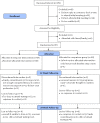A Web-Based Intervention to Encourage Walking (StepWise): Pilot Randomized Controlled Trial
- PMID: 26810251
- PMCID: PMC4746436
- DOI: 10.2196/resprot.4288
A Web-Based Intervention to Encourage Walking (StepWise): Pilot Randomized Controlled Trial
Abstract
Background: Despite Internet-based interventions that incorporate pedometers with appropriate goal-setting processes and other theoretically-based behavior change strategies being proposed as a means of increasing walking behavior, few have incorporated all of these key features or assessed maintenance of behavior change.
Objective: The objective of our study was to investigate the effect of a 12-week pedometer step goal walking program individually tailored to baseline step counts, combined with an interactive support website for step counts, health parameters and motivation over 12 and 24 weeks.
Methods: Low active participants (mean [SD] 46.2 [11.2] years) were randomly assigned to the Stepwise (SW) intervention group (n=49) or a comparison (CP) group (n=48). SW received a pedometer, step goal walking program and access to the SW website (containing interactive self-monitoring and goal feedback tools, motivational messages and action and coping planning strategies). CP received a pedometer and locally available physical activity information. Step counts, BMI, resting heart rate, blood pressure and glucose, cholesterol and triglyceride levels, psychological well-being, perceived health, self-efficacy and self-determined motivation were measured at baseline, 12 and 24 weeks.
Results: Linear mixed model analysis found that both groups' step counts increased from baseline to week 12 (β = 11,002, CI 5739-16,266, P<.001) and 24 (β = 6810, CI 1190-12,431; P=.02). Group step counts were significantly different at week 24 with SW taking 8939 (CI 274-17604, P=.04) more steps compared to CP. Compared to baseline, both groups had improved triglyceride levels (0.14 mmol/L, CI -0.25 to -0.02, P=.02) at week 12, decreased diastolic blood pressure (4.22 mmHg, CI -6.73 to -1.72) at weeks 12 and 24 (3.17 mmHg, CI -5.55 to -0.78), improved positive (β = .21, CI 0.03-0.38, P=.02) and negative affect (β = -.15, CI -0.28 to -0.03, P=.02) at week 12, and perceived health at week 12 (β = 6.37, CI 2.10-10.65, P=.004) and 24 (β = 8.52, CI 3.98-13.06, P<.001). Total cholesterol increased at week 12 (0.26 mmol/L, CI 0.099-0.423, P=.006) and week 24 (0.38 mmol/L, CI 0.20-0.56, P<.001). Repeated measures ANOVA found motivation for walking improved from baseline with higher task self-efficacy (P<.001, η(2) = .13) and autonomous motivation (P<.001, η(2)=.14) at weeks 12 and 24 and decreased controlled motivation (P=.004, η(2)=.08) at week 24.
Conclusions: Both groups had similar improvements in step counts and physical and psychological health after 12 weeks but only the SW group successfully maintained the increased step-counts 24 weeks post-intervention. This suggests the step-goal based walking program combined with Internet-based behavior change tools were important for sustained behavior change.
Keywords: physical activity, behavior change strategies, pedometer, self-monitoring, step goal walking program.
Conflict of interest statement
Conflicts of Interest: None declared.
Figures




Similar articles
-
Long-Term Effects of an Internet-Mediated Pedometer-Based Walking Program for Chronic Obstructive Pulmonary Disease: Randomized Controlled Trial.J Med Internet Res. 2016 Aug 8;18(8):e215. doi: 10.2196/jmir.5622. J Med Internet Res. 2016. PMID: 27502583 Free PMC article. Clinical Trial.
-
An online community improves adherence in an internet-mediated walking program. Part 1: results of a randomized controlled trial.J Med Internet Res. 2010 Dec 17;12(4):e71. doi: 10.2196/jmir.1338. J Med Internet Res. 2010. PMID: 21169160 Free PMC article. Clinical Trial.
-
Social cognitive theory mediators of physical activity in a lifestyle program for cancer survivors and carers: findings from the ENRICH randomized controlled trial.Int J Behav Nutr Phys Act. 2016 Apr 14;13:49. doi: 10.1186/s12966-016-0372-z. Int J Behav Nutr Phys Act. 2016. PMID: 27075417 Free PMC article. Clinical Trial.
-
The effect of a pedometer-based community walking intervention "Walking for Wellbeing in the West" on physical activity levels and health outcomes: a 12-week randomized controlled trial.Int J Behav Nutr Phys Act. 2008 Sep 5;5:44. doi: 10.1186/1479-5868-5-44. Int J Behav Nutr Phys Act. 2008. PMID: 18775062 Free PMC article.
-
Using Step Counts to Prescribe Physical Activity: What Is the Optimal Dose?Curr Sports Med Rep. 2021 Aug 1;20(8):402-409. doi: 10.1249/JSR.0000000000000868. Curr Sports Med Rep. 2021. PMID: 34357886 Review.
Cited by
-
Motivating young adults to connect with nature for stress relief: A study in Taiwan during the COVID-19 pandemic.Front Psychiatry. 2022 Sep 6;13:922107. doi: 10.3389/fpsyt.2022.922107. eCollection 2022. Front Psychiatry. 2022. PMID: 36147970 Free PMC article.
-
User Models for Personalized Physical Activity Interventions: Scoping Review.JMIR Mhealth Uhealth. 2019 Jan 16;7(1):e11098. doi: 10.2196/11098. JMIR Mhealth Uhealth. 2019. PMID: 30664474 Free PMC article.
-
Interventions for Increasing Physical Activity: From "Ingenious Toys" to mHealth.J Am Coll Cardiol. 2016 May 31;67(21):2464-6. doi: 10.1016/j.jacc.2016.03.482. Epub 2016 Apr 3. J Am Coll Cardiol. 2016. PMID: 27050186 Free PMC article. No abstract available.
-
Development of a Self-Determination Theory-Based Physical Activity Intervention for Aged Care Workers: Protocol for the Activity for Well-being Program.Front Public Health. 2018 Nov 26;6:341. doi: 10.3389/fpubh.2018.00341. eCollection 2018. Front Public Health. 2018. PMID: 30534548 Free PMC article.
-
Web-based intervention on the promotion of physical activity among Iranian youth using the transtheoretical model.J Educ Health Promot. 2020 May 28;9:118. doi: 10.4103/jehp.jehp_36_20. eCollection 2020. J Educ Health Promot. 2020. PMID: 32642474 Free PMC article.
References
-
- Warburton DER, Nicol CW, Bredin SSD. Health benefits of physical activity: the evidence. CMAJ. 2006 Mar 14;174(6):801–809. doi: 10.1503/cmaj.051351. http://www.cmaj.ca/cgi/pmidlookup?view=long&pmid=16534088 174/6/801 - DOI - PMC - PubMed
-
- World Health Organization . WHO.int. Geneva, Switzerland: World Health Organization; 2010. [2015-12-06]. Global Status Report on Noncommunicable Diseases 2010 http://www.who.int/nmh/publications/ncd_report_full_en.pdf .
-
- Sport and Recreation New Zealand SportNZ.org. 2008. [2015-12-07]. Sport, Recreation and Physical Activity Participation Among New Zealand Adults: Key Results of the 2007/08 Active NZ Survey http://www.sportnz.org.nz/assets/uploads/attachments/managing-sport/rese... .
-
- Hillsdon M, Thorogood M. A systematic review of physical activity promotion strategies. Br J Sports Med. 1996 Jun;30(2):84–89. http://bjsm.bmj.com/cgi/pmidlookup?view=long&pmid=8799589 - PMC - PubMed
LinkOut - more resources
Full Text Sources
Other Literature Sources
Miscellaneous

